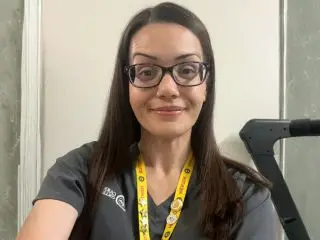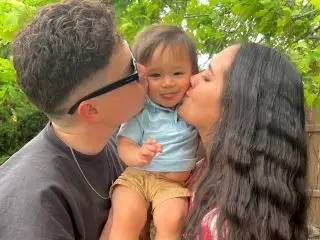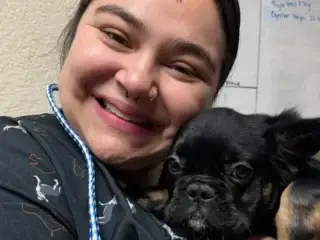When Chrissy Hernandez started the Physical Therapist Assistant (PTA) program at the Carrington College Mesa Campus in December of 2017, she was most interested in working with athletes. She is an athlete herself and has incurred multiple injuries playing sports. That was how she was first exposed to physical therapy. She sprained her ankle, injured her shoulder, “you name it—it happened to me along the way,” she said. It makes sense that other athletes would naturally be the most familiar and relatable patient population for her when she entered school. Then, experiences during her clinical rotation and caring for her sick grandfather opened her mind and ignited a change in her that made her path go a different and more fulfilling direction. She became far more interested in complex, acute injuries and eventually neurological diseases in the inpatient rehabilitation setting.
“I saw a completely different side of it with my grandpa than I saw with the sports side of it. With acute care patients, you are helping them with things like how to walk or how to get on or off the toilet. These are things that many of us take for granted. I thought it was more rewarding to help someone who could walk, got sick, couldn’t walk… and I was helping them relearn those basic skills. The patient population there is almost more grateful for your help. Athletes are more about ‘fix me up, fix me up,’” she said.
The realizations she had while working with her grandpa were advanced during her clinical rotation period at Carrington when she spent time at EnCompass Health Rehabilitation Hospital of Scottsdale. EnCompass describes itself as a “leading provider of inpatient rehabilitation for stroke, brain injury and other complex neurological and orthopedic conditions.” This means that they help patients who are recovering from injuries due to such things as traffic accidents, falls, and violent attacks. They also work with people who have had neurological events like an aneurysm or suffer from a chronic progressive disease like Multiple Sclerosis (MS). They might also assist patients after breaking their hip or learning to walk on a new prosthetic limb after amputation. The inpatient rehabilitative care that they provide also uses equipment like gait training systems that Chrissy hasn’t seen in an outpatient setting. Her experience there gave her a new perspective on what was possible for patients through inpatient rehabilitation while also challenging her in ways she hadn’t expected. She found that patients with complex neurological diseases required more of her intellectually and creatively, which was an experience she greatly enjoyed. She described rising to the challenge, “A sprained ankle is a sprained ankle—but this is much more complex. For instance with MS, not everybody with the same kind of MS is going to present to you in the same kind of way. With my last MS patient I was able to do this, this, and this… but if you go try the same thing with your next MS patient you might find that none of that is working even though they have the same disease. It is complex and you really have to think about how to help your patient. You have to tweak everything for each person. That is the kind of work I want to do.” Chrissy has worked with three MS patients so far and says that she finds working with them and tailoring their treatment particularly fulfilling. “I don’t love that people have this disease, but I do enjoy that there is variety within how the disease presents itself and so that part is challenging. It is also really rewarding to see people improve.” She described a patient who arrived at her rotation during a severe MS exacerbation and was unable to walk or even sit up. After receiving regular PT for several months, they were able to walk out unassisted. She said the patient was crying because they were so happy about the improvements they had made. These improvements were exciting and motivating for Chrissy to witness. After that, she felt motivated to help more patients with neurological diseases. This type of exacerbation with the recovery of ability is characteristic of the Relapsing-Remitting MS (RRMS) disease course. Multiple Sclerosis is the most common disabling neurological disease of young adults in the United States and RRMS is the most common initial form of the disease. New estimates state that approximately 1 million Americans suffer from MS, which is about twice the amount that was believed until a comprehensive study in 2017. This means it is likely that most students entering the PTA field will encounter patients with this disease, especially in this form, during their careers. According to the National Multiple Sclerosis Society (NMSS), RRMS is “defined attacks of new or increasing neurologic symptoms. These attacks – also called relapses or exacerbations – are followed by periods of partial or complete recovery (remissions).” RRMS patients typically accumulate damage from their attacks and about half have historically transitioned into a progressive form of the disease known as Secondary Progressive MS (SPMS) where mobility and other functions are permanently affected. There is hope that new pharmaceutical treatments for RRMS that have emerged in the past decade will help minimize the number of patients who transition to SPMS but it is still too soon to tell. The NMSS states that “during these inflammatory attacks, activated immune cells cause small, localized areas of damage.”
This damage disrupts the communication between nerves, which causes the symptoms of the attack. These symptoms can vary greatly between RRMS patients, ranging from sensory changes like reduced feeling and numbness in limbs, double-vision or blindness from optic nerve involvement, and/or even severe mobility challenges like the patient Chrissy described—to name just a few common ones. This means their PT needs can be complex. Chrissy wants to help find custom solutions based on each patient’s unique presentation of the disease. “I want to be their advocate,” she said.
She was a bit surprised by the revelation that she liked working with the inpatient, acute care rehab population so much and was thankful for the clinical rotation period at Carrington that opened her eyes to that population. She said, “When they were initially placing us for our clinical placements I wanted to work with athletes, that’s what I wanted to do. Then, you know you have to do one inpatient rotation, that is non-negotiable. I thought, ‘Fine, I’ll do it if I have to.’ And I ended up absolutely loving it. I remember when they came to talk to me at the end of my rotations, ‘which one is it, inpatient or outpatient?’ I wasn’t expecting to like my inpatient rotation as much as I did. I fell in love with that patient population.” Chrissy’s mom even remarked about enjoying seeing the “light that burned inside her” when she talked about working with the acute care inpatient population. Her passion was contagious. She went on to graduate at the top of her class and work with Diana Jimenez in Career Services at Carrington to find employment in the Mesa area. “It was really great because Diana kept sending my application in and searching for me. She was asking whoever she knew,” she said. And thankfully, a fantastic opportunity came along through Diana for a full-time inpatient rehab position. Today, Chrissy is working at Citadel Post Acute Short-Term Inpatient Rehabilitation in Mesa. They have 128 beds and mostly provide care to elderly patients recovering from injuries due to degenerative changes related to aging, such as a stroke or broken hip. Chrissy said they also occasionally care for younger patients with disabling conditions and serious injuries. Their website describes their PT staff as “the heart of Citadel Post Acute.” One of the things that Chrissy enjoys about the inpatient setting at Citadel is the community feeling that gives her an opportunity to develop a rapport with the patients living on-site. She spends more time with her patients in that setting than she would with outpatient clients and, in the time of COVID-19 restrictions, more time with them than their family and friends. When patients enter the facility, often after leaving the hospital or a long-term care facility, they are isolated in their rooms for fourteen days because of Coronavirus. She has noticed that they tend to feel very isolated and so PT is often the highlight of their day, but that doesn’t always mean they are up for a lot of movement and exercise. She said that she has learned to listen to her patients’ limits and not push them too hard. If they aren’t up for exercise, maybe they are at least up for coloring pictures and talking. Chrissy has found that to be a healthy, trust-building exercise that keeps them engaged and moving forward. She is constantly learning from her patients and growing as a PTA.
Chrissy considers her time at Citadel a great foundational experience for her as a new PTA in the inpatient environment while earning Arizona’s required observation hours. Her long-term goal is to focus more on the complex neurological cases that she finds so fulfilling. She wants to help design custom treatment plans that help patients regain lost abilities and reach their goals. Even if Chrissy isn’t working with athletes, she is still true to her nature as one—she loves a good challenge and won’t give up until she reaches the finish line.



